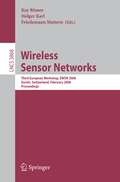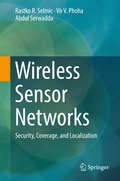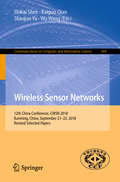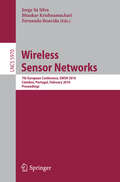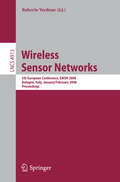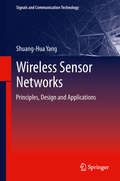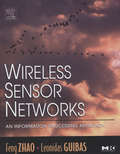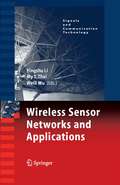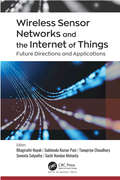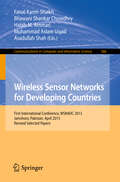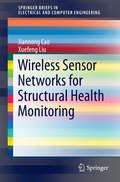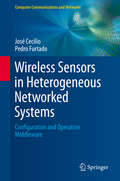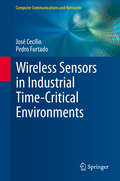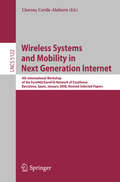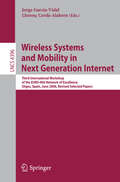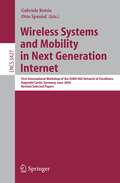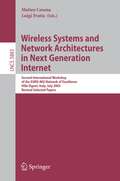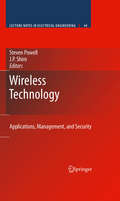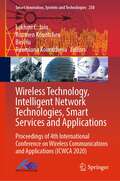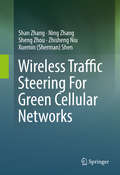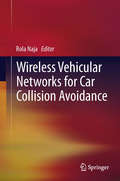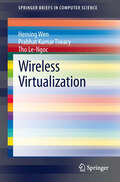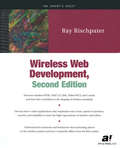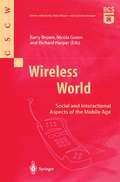- Table View
- List View
Wireless Sensor Networks: Third European Workshop, EWSN 2006, Zurich, Switzerland, February 13-15, 2006, Proceedings (Lecture Notes in Computer Science #3868)
by Kay Römer Holger Karl Friedemann MatternThis book constitutes the refereed proceedings of the Third European Workshop on Wireless Sensor Networks February 2006. The 21 revised full papers presented together with the abstracts of one invited talk and two tutorials were carefully reviewed and selected from 133 submissions. The papers are organized in topical sections on query systems, sensor network services, routing, localization, platforms and development, medium access control, and measurements.
Wireless Sensor Networks: Security, Coverage, and Localization (Advances In Information Security Ser. #Vol. 69)
by Rastko R. Selmic Vir V. Phoha Abdul SerwaddaThis book presents a comprehensive overview of wireless sensor networks (WSNs) with an emphasis on security, coverage, and localization. It offers a structural treatment of WSN building blocks including hardware and protocol architectures and also provides a systems-level view of how WSNs operate. These building blocks will allow readers to program specialized applications and conduct research in advanced topics.A brief introductory chapter covers common applications and communication protocols for WSNs. Next, the authors review basic mathematical models such as Voroni diagrams and Delaunay triangulations. Sensor principles, hardware structure, and medium access protocols are examined. Security challenges ranging from defense strategies to network robustness are explored, along with quality of service measures. Finally, this book discusses recent developments and future directions in WSN platforms.Each chapter concludes with classroom-tested exercises that reinforce key concepts. This book is suitable for researchers and for practitioners in industry. Advanced-level students in electrical engineering and computer science will also find the content helpful as a textbook or reference.
Wireless Sensor Networks: 12th China Conference, CWSN 2018, Kunming, China, September 21–23, 2018, Revised Selected Papers (Communications in Computer and Information Science #984)
by Shikai Shen Kaiguo Qian Shaojun Yu Wu WangThis book constitutes the refereed proceedings of the 12th China Conference on Wireless Sensor Networks, CWSN 2018, held in Kunming, China, in September 2018. The 16 revised full papers were carefully reviewed and selected from 177 submissions. The papers are organized in topical sections on algorithm for wireless sensor network; positioning and location; neural network; energy efficiency and harvesting; privacy and security; image processing.
Wireless Sensor Networks: 7th European Conference, EWSN 2010, Coimbra, Portugal, February 17-19, 2010, Proceedings (Lecture Notes in Computer Science #5970)
by Jorge Sá Silva Bhaskar Krishnamachari Fernando BoavidaIt is our great pleasure to present the proceedings of the European Conference on Wireless Sensor Networks 2010 (EWSN 2010). As the field of wireless sensor networks matures, new design concepts, experim- tal and theoretical findings, and applications have continued to emerge at a rapid pace. As one of the leading international conferences in this area, EWSN has played a s- stantial role in the dissemination of innovative research ideas from researchers all over the globe. EWSN 2010 was organized by the University of Coimbra, Portugal, during February 17–19, 2010 and it was the seventh meeting in this series. Previous events were held in Berlin (Germany) in 2004, Istanbul (Turkey) in 2005, Zurich (Switz- land) in 2006, Delft (The Netherlands) in 2007, and Cork (Ireland) in 2009. A high-quality selection of papers made up EWSN 2010. Based on the reviews and the recommendations from the four live TPC discussions, we selected a total of 21 papers from 109 submissions (19.26% acceptance rate) for EWSN 2010. Topics of interest included hardware design and implementation, operating systems and so- ware, middleware and macroprogramming, communication and network protocols, information and signal processing, fundamental theoretical limits and algorithms, prototypes, field experiments, testbeds, novel applications, including urban sensing, security and fault-tolerance. Putting together EWSN 2010 was a team effort. We would like to thank the P- gram Committee members, the reviewers, our sponsors, all authors, and the Organ- ing Committee for their respective contributions.
Wireless Sensor Networks: 5th European Conference, EWSN 2008, Bologna, Italy, January 30-February 1, 2008, Proceedings (Lecture Notes in Computer Science #4913)
by Roberto VerdoneWireless Sensor Networks: Principles, Design and Applications (Signals and Communication Technology)
by Shuang-Hua YangWireless Sensor Networks presents the latest practical solutions to the design issues presented in wireless-sensor-network-based systems. Novel features of the text, distributed throughout, include workable solutions, demonstration systems and case studies of the design and application of wireless sensor networks (WSNs) based on the first-hand research and development experience of the author, and the chapters on real applications: building fire safety protection; smart home automation; and logistics resource management. Case studies and applications illustrate the practical perspectives of:· sensor node design;· embedded software design;· routing algorithms;· sink node positioning;· co-existence with other wireless systems;· data fusion;· security;· indoor location tracking;· integrating with radio-frequency identification; and· Internet of thingsWireless Sensor Networks brings together multiple strands of research in the design of WSNs, mainly from software engineering, electronic engineering, and wireless communication perspectives, into an over-arching examination of the subject, benefiting students, field engineers, system developers and IT professionals. The contents have been well used as the teaching material of a course taught at postgraduate level in several universities making it suitable as an advanced text book and a reference book for final-year undergraduate and postgraduate students.
Wireless Sensor Networks: An Information Processing Approach (ISSN)
by Feng Zhao Leonidas GuibasInformation processing in sensor networks is a rapidly emerging area of computer science and electrical engineering research. Because of advances in micro-sensors, wireless networking and embedded processing, ad hoc networks of sensor are becoming increasingly available for commercial, military, and homeland security applications. Examples include monitoring (e.g., traffic, habitat, security), industrail sensing and diagnostics (e.g., factory, appliances), infrastructures (i.e., power grid, water distribution, waste disposal) and battle awareness (e.g., multi-target tracking). This book introduces practitioners to the fundamental issues and technology constraints concerning various aspects of sensor networks such as information organization, querying, routing, and self-organization using concrete examples and does so by using concrete examples from current research and implementation efforts.Written for practitioners, researchers, and students and relevant to all application areas, including environmental monitoring, industrial sensing and diagnostics, automotive and transportation, security and surveillance, military and battlefield uses, and large-scale infrastructural maintenanceSkillfully integrates the many disciplines at work in wireless sensor network design: signal processing and estimation, communication theory and protocols, distributed algorithms and databases, probabilistic reasoning, energy-aware computing, design methodologies, evaluation metrics, and moreDemonstrates how querying, data routing, and network self-organization can support high-level information-processing tasks
Wireless Sensor Networks and Applications (Signals and Communication Technology)
by Yingshu Li My T. ThaiA crucial reference tool for the increasing number of scientists who depend upon sensor networks in a widening variety of ways. Coverage includes network design and modeling, network management, data management, security and applications. The topic covered in each chapter receives expository as well as scholarly treatment, covering its history, reviewing state-of-the-art thinking relative to the topic, and discussing currently unsolved problems of special interest.
Wireless Sensor Networks and the Internet of Things: Future Directions and Applications
by Bhagirathi NayakWireless Sensor Networks and the Internet of Things: Future Directions and Applications explores a wide range of important and real-time issues and applications in this ever-advancing field. Different types of WSN and IoT technologies are discussed in order to provide a strong framework of reference, and the volume places an emphasis on solutions to the challenges of protection, conservation, evaluation, and implementation of WSN and IoT that lead to low-cost products, energy savings, low carbon usage, higher quality, and global competitiveness. The volume is divided into four sections that cover: Wireless sensor networks and their relevant applications Smart monitoring and control systems with the Internet of Things Attacks, threats, vulnerabilities, and defensive measures for smart systems Research challenges and opportunities This collection of chapters on an important and diverse range of issues presents case studies and applications of cutting-edge technologies of WSN and IoT that will be valuable for academic communities in computer science, information technology, and electronics, including cyber security, monitoring, and data collection. The informative material presented here can be applied to many sectors, including agriculture, energy and power, resource management, biomedical and health care, business management, and others.
Wireless Sensor Networks and the Internet of Things: Future Directions and Applications
by Bhagirathi Nayak Subhendu Kumar Pani Tanupriya Choudhury Suneeta Satpathy Sachi Nandan MohantyWireless Sensor Networks and the Internet of Things: Future Directions and Applications explores a wide range of important and real-time issues and applications in this ever-advancing field. Different types of WSN and IoT technologies are discussed in order to provide a strong framework of reference, and the volume places an emphasis on solutions to the challenges of protection, conservation, evaluation, and implementation of WSN and IoT that lead to low-cost products, energy savings, low carbon usage, higher quality, and global competitiveness. The volume is divided into four sections that cover: Wireless sensor networks and their relevant applications Smart monitoring and control systems with the Internet of Things Attacks, threats, vulnerabilities, and defensive measures for smart systems Research challenges and opportunities This collection of chapters on an important and diverse range of issues presents case studies and applications of cutting-edge technologies of WSN and IoT that will be valuable for academic communities in computer science, information technology, and electronics, including cyber security, monitoring, and data collection. The informative material presented here can be applied to many sectors, including agriculture, energy and power, resource management, biomedical and health care, business management, and others.
Wireless Sensor Networks for Developing Countries: First International Conference, WSN4DC 2013, Jamshoro, Pakistan, April 24-26, 2013, Revised Selected Papers (Communications in Computer and Information Science #366)
by Faisal Karim Shaikh Bhawani Shankar Chowdhry Habib M. Ammari Muhammad Aslam Uqaili Assadullah ShahThis book constitutes the refereed proceedings of the First International Conference on Wireless Sensor Networks for Developing Countries, WSN4DC 2013, held in Jamshoro, Pakistan, in April 2013. The 10 revised full papers presented were carefully reviewed and selected from 30 submissions. The papers are organized in topical sections on WSN applications/services for developing countries; mobile WSN; underwater WSN; VANETS; body area networks; energy harvesting in WSN; WSN and cloud integration; WSN and IoT; QoS and Qot; WSN MAC, network and transport protocols; cross layer approaches; security aspects in WSN; WSN applications in smart grid and energy management; WSN in structural health monitoring.
Wireless Sensor Networks for Structural Health Monitoring (SpringerBriefs in Electrical and Computer Engineering #0)
by Jiannong Cao Xuefeng LiuThis brief covers the emerging area of wireless sensor network (WSN)-based structural health monitoring (SHM) systems, and introduces the authors’ WSN-based platform called SenetSHM. It helps the reader differentiate specific requirements of SHM applications from other traditional WSN applications, and demonstrates how these requirements are addressed by using a series of systematic approaches. The brief serves as a practical guide, explaining both the state-of-the-art technologies in domain-specific applications of WSNs, as well as the methodologies used to address the specific requirements for a WSN application. In particular, the brief offers instruction for problem formulation and problem solving based on the authors’ own experiences implementing SenetSHM. Seven concise chapters cover the development of hardware and software design of SenetSHM, as well as in-field experiments conducted while testing the platform. The brief’s exploration of the SenetSHM platform is a valuable feature for civil engineers designing their own similar SHM products, and the various concrete examples of problem formulation and algorithm design will make this an essential read for practitioners, researchers and students alike.
Wireless Sensors in Heterogeneous Networked Systems: Configuration and Operation Middleware (Computer Communications and Networks)
by José Cecílio Pedro FurtadoThis book presents an examination of the middleware that can be used to configure and operate heterogeneous node platforms and sensor networks. The middleware requirements for a range of application scenarios are compared and analysed. The text then defines middleware architecture that has been integrated in an approach demonstrated live in a refinery. Features: presents a thorough introduction to the major concepts behind wireless sensor networks (WSNs); reviews the various application scenarios and existing middleware solutions for WSNs; discusses the middleware mechanisms necessary for heterogeneous WSNs; provides a detailed examination of platform-agnostic middleware architecture, including important implementation details; investigates the programming paradigms for WSNs, and for heterogeneous sensor networks in general; describes the results of extensive experimentation and testing, demonstrating that the generic architecture is viable for implementation on multiple platforms.
Wireless Sensors in Industrial Time-Critical Environments (Computer Communications and Networks)
by José Cecílio Pedro FurtadoThis book introduces the fundamentals of DCS, and shows how to include wireless technology in their design while guaranteeing the desired operation characteristics. The text also presents insights and results gained from extensive practical experience in implementing and testing systems within a specific industrial setting. Features: examines the operations that the DCS implements, covering human-machine interfaces, diagnostics and maintenance interfaces, and controllers; discusses industrial control system and wireless network protocols; reviews scheduling in wireless sensor networks; describes a latency model for heterogeneous DCS with wired and wireless parts, that predicts monitoring, command, and closed loop latencies; explains how to plan operation timings systematically; introduces measures and metrics for performance monitoring and debugging, and describes how to add these to a system; presents experimental results to validate the planning approach, based on an application test-bed.
Wireless Systems and Mobility in Next Generation Internet: 4th International Workshop of the EuroNGI/EuroFGI Network of Excellence Barcelona, Spain, January 16-18, 2008. Revised Selected Papers (Lecture Notes in Computer Science #5122)
by Llorenç Cerdà-AlabernWireless Systems and Mobility in Next Generation Internet: Third International Workshop of the EURO-NGI Network of Excellence, Sitges, Spain, June 6-9, 2006, Revised Selected Papers (Lecture Notes in Computer Science #4396)
by Jorge García-Vidal Llorenc Cerdà-AlabernThis book is the thoroughly refereed post-proceedings of the Third International Workshop on Wireless and Mobility organized by the European Network of Excellence on Next Generation Internet held in Spain, June 2006. It covers WLAN characterization, vehicular networks, WLAN and sensor networks protocols, QoS and routing in ad-hoc networks, heterogeneous networks, resource management in cellular networks, TCP in wireless, and mobility agents.
Wireless Systems and Mobility in Next Generation Internet: First International Workshop of the EURO-NGI Network of Excellence, Dagstuhl Castle, Germany, June 7-9, 2004, Revised Selected Papers (Lecture Notes in Computer Science #3427)
by Gabriele Kotsis Otto SpaniolThe Internet is subject to permanent modi?cations and to continuous restr- turing. This is primarily due to the tremendous rise in demand for bandwidth by the ever increasing number of users. When compared to the early years of the Internet the quality of the services o?ered had to be signi?cantly improved in di?erent respects (delay, network and service availability, jitter,. . . )inorder to satisfy the needs of many new applications. Within the last decade two new developments have contributed to many new opportunities, as well as to a need for intensive research and development: – the increased mobility of users together with the desire for ubiquitous hi- quality access to all o?ered services, at reasonable cost; – the use of wireless communication. Despite their relatively low capacity (when compared with ?xed backbone n- works) the use of radio links supports the ubiquitous availability of Internet services in a quasiperfect way. A considerable amount of research and development activities are currently - ing on worldwide in order to adapt Internet services to the particular needs of mobile users and of wireless communication links. These questions were - tensively discussed at the ?rst workshop organized by the EURO-NGI Network of Excellence (‘Next Generation Internet’), which has been funded by the - ropean Union since January 2004 under their IST programme.
Wireless Systems and Network Architectures in Next Generation Internet: Second International Workshop of the EURO-NGI Network of Excellence, Villa Vigoni, Italy, July 13-15, 2005, Revised Selected Papers (Lecture Notes in Computer Science #3883)
by Matteo Cesana Luigi FrattaThis book constitutes the refereed post-proceedings of the second international joint workshops on Wireless and Mobility and on New Trends in Network Architectures and Services organized by the European Network of Excellence on Next Generation Internet, EURO-NGI 2005. The 19 revised full research papers presented together with 1 invited talk are organized in topical sections on wireless solutions, QoS support in next generation networks, and peer to peer architectures and algorithms.
Wireless Technology: Applications, Management, and Security (Lecture Notes in Electrical Engineering #44)
by Steven Powell J. P. ShimWireless technology and handheld devices are dramatically changing the degrees of interaction throughout the world, further creating a ubiquitous network society. The emergence of advanced wireless telecommunication technologies and devices in today’s society has increased accuracy and access rate, all of which are increasingly essential as the volume of information handled by users expands at an accelerated pace. The requirement for mobility leads to increasing pressure for applications and wireless systems to revolve around the concept of continuous communication with anyone, anywhere, and anytime. With the wireless technology and devices come ?exibility in network design and quicker deployment time. Over the past decades, numerous wireless telecommu- cation topics have received increasing attention from industry professionals, a- demics, and government agencies. Among these topics are the wireless Internet; multimedia; 3G/4G wireless networks and systems; mobile and wireless network security; wireless network modeling, algorithms, and simulation; satellite based s- tems; 802.11x; RFID; and broadband wireless access.
Wireless Technology, Intelligent Network Technologies, Smart Services and Applications: Proceedings of 4th International Conference on Wireless Communications and Applications (ICWCA 2020) (Smart Innovation, Systems and Technologies #258)
by Lakhmi C. Jain Roumen Kountchev Bin Hu Roumiana KountchevaThis book gathers selected papers presented at the 4th International Conference on Wireless Communications and Applications (ICWCA 2020), held at Hainan University, China. The second volume will involve research works aimed at the contemporary applications: emerging wireless/mobile applications, context and location-aware wireless services; wireless telemedicine and e-health services; intelligent transportation systems; RFID technology and application; cognitive radio and sensor-based applications; content distribution in wireless home environment and many others.
Wireless Traffic Steering For Green Cellular Networks
by Shan Zhang Ning Zhang Sheng Zhou Zhisheng Niu Xuemin (Sherman) ShenThis book introduces wireless traffic steering as a paradigm to realize green communication in multi-tier heterogeneous cellular networks. By matching network resources and dynamic mobile traffic demand, traffic steering helps to reduce on-grid power consumption with on-demand services provided. This book reviews existing solutions from the perspectives of energy consumption reduction and renewable energy harvesting. Specifically, it explains how traffic steering can improve energy efficiency through intelligent traffic-resource matching. Several promising traffic steering approaches for dynamic network planning and renewable energy demand-supply balancing are discussed. This book presents an energy-aware traffic steering method for networks with energy harvesting, which optimizes the traffic allocated to each cell based on the renewable energy status. Renewable energy demand-supply balancing is a key factor in energy dynamics, aimed at enhancing renewable energy sustainability to reduce on-grid energy consumption. Dynamic network planning adjusts cell density with traffic variations to provide on-demand service, which reduces network power consumption with quality of service provisioning during off-peak hours. With intra- or inter-tier traffic steering, cell density is dynamically optimized with regards to the instant traffic load for conventional homogeneous and multi-tier heterogeneous cellular networks, respectively. This book is beneficial for researchers and graduate students interested in traffic management and future wireless networking.
Wireless Vehicular Networks for Car Collision Avoidance
by Rola NajaWireless Vehicular Networks for Car Collision Avoidance focuses on the development of the ITS (Intelligent Transportation Systems) in order to minimize vehicular accidents. The book presents and analyses a range of concrete accident scenarios while examining the causes of vehicular collision and proposing countermeasures based on wireless vehicular networks.The book also describes the vehicular network standards and quality of service mechanisms focusing on improving critical dissemination of safety information. With recommendations on techniques and protocols to consider when improving road safety policies in order to minimize crashes and collision risks.
Wireless Virtualization (SpringerBriefs in Computer Science)
by Heming Wen Prabhat Kumar Tiwary Tho Le-NgocThis SpringerBriefs is an overview of the emerging field of wireless access and mobile network virtualization. It provides a clear and relevant picture of the current virtualization trends in wireless technologies by summarizing and comparing different architectures, techniques and technologies applicable to a future virtualized wireless network infrastructure. The readers are exposed to a short walkthrough of the future Internet initiative and network virtualization technologies in order to understand the potential role of wireless virtualization in the broader context of next-generation ubiquitous networks. Three main wireless virtualization perspectives are explored, along with the potential challenges and requirements of a sustainable wireless virtualization framework. Finally, it presents an example of a multi-perspective wireless virtualization framework. The readers learn the latest concepts in the application of wireless virtualization as well as its relationship with cutting-edge wireless technologies such as software-defined radio (SDR) and cognitive radio.
Wireless Web Development
by Ray RischpaterRischpater's second edition has new coverage of HTML, WAP 2.0, XML, Palm's WCA and iMode in detail and improves the text of the first edition with time-tested information.
Wireless World: Social and Interactional Aspects of the Mobile Age (Computer Supported Cooperative Work)
by RichardHarper NicolaGreen BarryBrownDespite the massive growth of mobile technologies, very little research has been done on how these technologies influence human interaction. Most of the published work in this area focuses on technological aspects and not on the social implications the technology is having on society. This book aims to fill this gap by providing an overview of these issues. It identifies the major trends, discusses the main claims made about the mobile age, and looks at issues which affect design, usability and evaluation. This unique look at the mobile age provides many interesting and important insights and will appeal to anyone designing, testing, or studying mobile devices.
